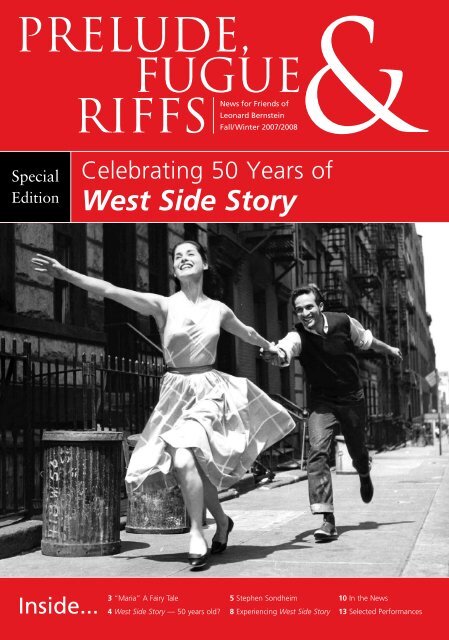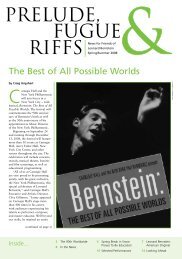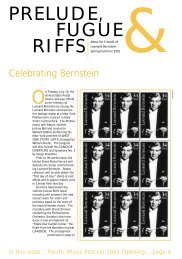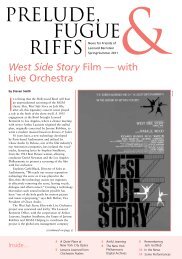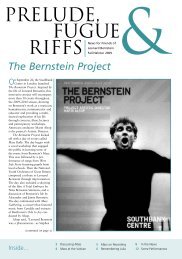West Side Story - Leonard Bernstein
West Side Story - Leonard Bernstein
West Side Story - Leonard Bernstein
Create successful ePaper yourself
Turn your PDF publications into a flip-book with our unique Google optimized e-Paper software.
COURTESY LIBRARY OF CONGRESSPrelude, Fugue & Riffs Fall/Winter 2007/2008How can something be as fresh, as brilliant,as explosively urgent as “<strong>West</strong> <strong>Side</strong><strong>Story</strong>,” and be 50 years old? How can thisbrand new idea for the American theatrehave been around for half a century?<strong>Leonard</strong> <strong>Bernstein</strong> used to say that hewished he could write the Great AmericanOpera. He was still designing such a projectshortly before his death. But in retrospect,we can say that he fulfilled his wish. “<strong>West</strong><strong>Side</strong> <strong>Story</strong>” is performed to enthusiasticaudiences in opera houses around the world— recently in La Scala and, before this yearis out, at the Théâtre du Châtelet in Paris.Is there a Broadway revival in the works?The signs are highly auspicious.In this issue, we celebrate “<strong>West</strong> <strong>Side</strong><strong>Story</strong>”: its authors, its original performers,and its continuing vital presence in the world.Chita Rivera regrets that, due to schedulingconflicts, she was unable to contribute tothis issue by print time.“<strong>West</strong> <strong>Side</strong> <strong>Story</strong>” continues to breakground to this very day. Earlier this year, theshow was performed by inmates at Sing Sing.A few months later, it was presented as partof a conflict resolution initiative for warringstreet gangs in Seattle. And if there’s a heaven,<strong>Leonard</strong> <strong>Bernstein</strong> was up there dancing forjoy last summer while Gustavo Dudamelled his sensational 200-piece Simón BolívarYouth Orchestra in the “Mambo” at theProms in London. The audience went bonkers.Check it out: http://www.dailymotion.com/swf/6pXLfR6OdUfQNjMYZThere are few theatrical experiences asreliably thrilling as a student production of“<strong>West</strong> <strong>Side</strong> <strong>Story</strong>”. In high schools andcolleges across America, teenagers throwthemselves into the show with the passionatecommitment that comes from feeling that awork of art is speaking directly to one’s soul.<strong>Leonard</strong> <strong>Bernstein</strong>’s score is notoriously difficult,but the young musicians and singerstear into it with gusto. The DVD of “<strong>West</strong><strong>Side</strong> <strong>Story</strong>” is a top rental for kids, whoseparents marvel as their 5 year olds jumparound the furniture playing “Jets and Sharks”and singing at the top of their lungs. Clearly“<strong>West</strong> <strong>Side</strong> <strong>Story</strong>” speaks in some essentialway to young people — and that, above all,is the quality that will keep this work itselfforever young.J.B. ■2
<strong>West</strong> <strong>Side</strong> <strong>Story</strong> — 50 years old?Prelude, Fugue & Riffs Fall/Winter 2007/20084by Reri GristStrange! — it seems only ashort time ago that we, theSharks and Jets girls, wereupstairs in our large, commondressing room on an upper floorof the Winter Garden Theaterchatting away happily as wechanged into our vibrant redand lavender or bright yellowand blue costumes, preparing forthe next evening show. Althoughwe originated from different partsof the USA, from sometimes contrastingsocial and educationalbackgrounds, we were joinedtogether to perform a new kindof musical which unexplainablymoved and united all of usbeyond anything else we hadbefore known or seen.During the early period ofrehearsals Jerome Robbins, thestage director and great choreographer,was the kingpin. Hewanted all of us to have theenergy and life he saw in thekids in the area of NYC whereI grew up — Spanish Harlem.Jerry wanted WSS to be like thereal thing. So we all, especiallythe dancers, dedicated ourselvesto the task and worked withoutholding anything back to givehim all that he wanted — andmore. I, in my role of Consuelo,had the privilege to be the firstto sing “There’s a place for us,”(“Somewhere”) which, in thecontext of the rivaling gangs, Ifelt I particularly understood. Aswe began to coordinate the scenesand music into a unified wholeon stage, there was increasedcontact with <strong>Leonard</strong> <strong>Bernstein</strong>,whose warmth, guidance andunrestrained enthusiasm with ourinterpretations of his compositioncreated an atmosphere which encouragedus to keep on movin’ on.<strong>West</strong> <strong>Side</strong> <strong>Story</strong> allowed me,personally, the opportunity toconvince Mr. <strong>Bernstein</strong> that “Icould sing other music, too,”such as Zerbinetta’s aria fromAriadne auf Naxos by RichardStrauss. And I do remember thataudition! Between a matinee andevening show, racing up 7thAvenue to Carnegie Hall withsome of the Shark girls alongwith me, all still wearing partsof our colorful costumes. Thestage of the great hall seemed sobig and intimidating to little me.When I finished the long anddifficult aria, Mr. <strong>Bernstein</strong>’s reaction,“Well, I guess you can sing!”led me on to other engagementsin concert with him and the NewYork Philharmonic. Years later,after my operatic career had beenestablished in Europe and theUSA, we again worked togetherat the Vienna State Opera inAustria where he conducted abeautiful new production ofStrauss’s Der Rosenkavalier inwhich I sang the role of Sophie.Stephen Sondheim and <strong>Leonard</strong> <strong>Bernstein</strong> rehearse the original cast.© BILLY ROSE THEATRE collectionReri Grist and <strong>Leonard</strong> <strong>Bernstein</strong>, 1971Whenever and wherever I see<strong>West</strong> <strong>Side</strong> <strong>Story</strong> listed to be performed— on stage, in selectionsin concert, in jazz or chamberarrangements, in Italy, Germany,China or South Africa, in French,Russian, or Japanese — my heartskips a beat, and I am thrownback in time to that first preopeningnight performance fora New York City audience at theWinter Garden. When the shotrang out that killed Tony andthe last chords softly diminishedinto space, we, the Sharks and theJets on stage and the audience intheir seats, remained frozen in anall encompassing silence, held bythe meaning of the killing — andperhaps the knowledge that wewere part of a great moment inAmerican theatre and music.At first, slowly and almost inaudibly,there arose an electrifyingroar from the audience — shouts,applause whistling, stamping offeet — which crescendoed intoa fortissimo causing the spaceand our beings to vibrate witha deafening joy of approvaland accomplishment.50 years ago… HAPPYBIRTHDAY WEST SIDESTORY! Keep movin’ on!“You done good buddy boy”—real good!■Reri Grist is an internationallyacclaimed opera singerand teacher.Courtesy rERI GRIST
Stephen SondheimI was worried about botheringStephen Sondheim with questionsabout <strong>West</strong> <strong>Side</strong> <strong>Story</strong>; surely,I thought, he’d prefer to talkabout the shows for which he’dwritten both lyrics and music.Robbins, Laurents and <strong>Bernstein</strong>were partway into the projectwhen Steve was brought in towork on the lyrics. But Stevesurprised me with his candoras well as his appreciation ofhis colleagues.— J.B.don’t mind talking about it, butI I have to be frank. I certainlyfeel the pride of being connectedto the show; I’m not ashamedof the show, but I’m not happyabout all of it, especially my ownstuff. I don’t like to hear peopleapologizing for their work inpublic — I think, oh come on, letthe work speak for itself — butI cringe when I hear Maria usedrawing-room words like “alarming”(in “I Feel Pretty”) and Tonywax poetic with lines like “Todaythe world was just an address.”Arthur wrote those charactersto speak simply and basically.From Lenny, Ilearned somethingabout not thinkingof music so squarely.You have four bars,do you really needall four? How aboutthree bars!Although I came in late on theshow, progress was not so considerable.Arthur had written athree-page synopsis of the action(no dialogue yet), and Lenny hadwritten only the chorus of “Cool”and the opening bars of “Maria”(apart, of course, from the tuneslike “Krupke,” “One Hand” and“America!,” which he had writtenfor previous projects and whichLeft to Right: Stephen Sondheim, Arthur Laurents, Harold Prince, Robert E. Griffith,<strong>Leonard</strong> <strong>Bernstein</strong>, and Jerome Robbins, circa 1957.he subsequently transferred to“<strong>West</strong> <strong>Side</strong>”). That’s as far asthey’d gotten.From each of the collaborators,I learned stuff that I have used orpassed along to other collaborators.From Arthur, I learned aboutsubtext and how necessary it is foractors. One time he took me withhim to the Actors’ Studio. WhenI asked why, he replied, “You’vegot to know the instrumentsyou’re working with...” The mostremarkable thing about Arthur’sbook is how spare it is, how muchplot he deals with in such a brieftime — brief because there’s somuch singing and dancing inthe show.From Lenny, I learned somethingabout not thinking of musicso squarely. You have four bars,do you really need all four? Howabout three bars! I was used tothinking in terms of four andeight-bar phrases. I also learnedfrom him about the only kinds ofchances worth taking: all the mistakeshe made were big ones —he never fell off the bottom rungof the ladder.From Jerry, I learned thatyou stage numbers in your headfirst. I had to play “Maria” forhim the first time he heard it —Lenny was out of town conductingsomewhere. When I gotfinished singing it, he said:“What’s going on on stage duringall of this?” “Uh, well, they’rechanging the set, and Tony’swalking to Maria’s —” Jerrycut me off, snapping, “That’s all?He’s just going to stand thereand sing? You stage it!” He wasright. If it’s a static song with noone else in the scene, and it’s inthe sort of show that’s trying totug you along in a story, thereshould be some stage action orsome development in the lyric(as in the “Soliloquy” fromCarousel). It’s up to the songwriterto plan it, to give thedirector a platform from whichto take off.As you know, I was hesitantto take the job, because I wantedto write music. But OscarHammerstein said, “Do it. It’llbe a wonderful opportunity,working with those people. Takeit on as a learning experience.”And guess what? I learned. ■© bILLY rOSE theatre collectionPrelude, Fugue & Riffs Fall/Winter 2007/20085
The True Gesture —Jerome Robbins and <strong>West</strong> <strong>Side</strong> <strong>Story</strong>by Amanda VaillAs credits go, it’s a small thing:a line, under the title, <strong>West</strong><strong>Side</strong> <strong>Story</strong>, that says, “Based ona conception of Jerome Robbins.”It’s not as prominent as the namesof book writer Arthur Laurents,composer <strong>Leonard</strong> <strong>Bernstein</strong>, orlyricist Stephen Sondheim; it’s notenshrined in a box, as Robbins’scredit for choreographing anddirecting the show is. But thoseseven words speak volumes aboutthe origins of this revolutionarymusical, and about the reasonsfor its success.When, in the late 1940’s,he famously advised the actorMontgomery Clift to play thecharacter of Romeo as if he were“among the gangs of New York,”Robbins had been struggling tocreate a dance-drama about disadvantagedurban youth for atleast a decade (there are at leasttwo unproduced scenarios on thistheme in his papers), and hadcreated a ballet (The Guests)about social intolerance. All theideas that would become <strong>West</strong><strong>Side</strong> <strong>Story</strong> were revolving inhis head already — includingthe notion of a “new theatrical© billy rose theatre collectionform,” what he called a “braiding”of dance, drama, and song,that would culminate in <strong>West</strong> <strong>Side</strong><strong>Story</strong>’s fluid musical narrative,where his choreography is as mucha means of plot and characterdevelopment as Laurents’s bookor <strong>Bernstein</strong> and Sondheim’s score.In this sense, certainly,<strong>Bernstein</strong> was accurate when hetold a Dramatists’ Guild symposiumthat “Jerry was our source”for <strong>West</strong> <strong>Side</strong> <strong>Story</strong>. But there wasa more important way in which<strong>Bernstein</strong>’s statement — andRobbins’s credit line — was true.What Robbins gave to the show,and what he encouraged hiscollaborators to give, was whathe called aspiration. “Why didLenny have to write an opera,Arthur a play, me a ballet... separatelyand elsewhere?” he said.“Why couldn’t we, in aspiration,try to bring our deepest talentstogether to the commercial theaterin this work? That was the truegesture of the show.”A half-century later, it still is. ■Amanda Vaill is currently writingthe screenplay for a 2-hour PBSAmerican Masters documentary onJerome Robbins; her biographyof him, entitled Somewhere, waspublished in late 2006.<strong>Leonard</strong> <strong>Bernstein</strong> and Jerome RobbinsPrelude, Fugue & Riffs Fall/Winter 2007/20086From Arthur Laurentsby Arthur LaurentsIn ’08, I will be directing a verydifferent production of <strong>West</strong><strong>Side</strong> <strong>Story</strong> that will open onBroadway in late November.It will be completely contemporarywithout changing a wordor a note, and without bringingin Uzis or mobile phones. Onething I can reveal here: theattitude of the gang memberswon’t so much change as be whatit always should have been. Onething will be missing: Lenny. Butthe greatest theatre music in musicaltheatre history will be presentand alive.■
<strong>Leonard</strong> <strong>Bernstein</strong>’s Orchestratorby Sid RaminBeing chosen to orchestrate for<strong>Leonard</strong> <strong>Bernstein</strong>, himself afine orchestrator, is akin to beingawarded the Medal of Honor. Iremember well the telephone callat 7:30 AM from Lenny askingme to orchestrate his new show,<strong>West</strong> <strong>Side</strong> <strong>Story</strong>, and the mixtureof fear and excitement thataccompanied it. That fear andexcitement quickly blended intoa modus operandis that resultedin some of the warmest and mostenjoyable experiences in workingon the show. I speak of whatLenny called “pre-orchestration”meetings and “post-orchestration”meetings.The meetings took place atLenny’s New York studio apartmentat the Osborne on <strong>West</strong>57th Street. At the pre-orchestrationmeeting, Lenny would sit atthe piano and play the materialto be orchestrated for me and myfriend Irv Kostal, who had agreedto work with me. Lenny wouldplay and explain to us what hethought about the instrumentationand general feeling of themusic. His remarks were alwaysjovial and quite revealing. Theatmosphere was warm and Isavored every moment.We would then sit togetherand discuss every measure of themusic at great length. These discussionswere so enjoyable that itwas hard to believe I was gettingpaid to do this. If we were hungry,Lenny would telephone to theStage Delicatessen for sandwiches,while we continued our exchangeof ideas.After the meeting, Irv andI would go to my studio, justacross the street, and reviewwhat we thought we would do.After some consolidating ofideas, Irv would take part ofthe material and I would keepmy half and we’d both put ournotes down on score paper atour respective homes.Next, came the “post-orchestration”meeting at Lenny’sstudio. Lenny would look atwhat we had done and comment.It was either “That’s good” or“Gee, that’s terrific!”, when Irvand I had thought of somethingnew to add, or “Now, why didyou do that?”, when Lenny didn’tagree with something we hadadded. I’m happy and proud tosay that Lenny usually acceptedan idea gratefully.Lenny had a red pencil andwould use it to edit what we haddone. He then used a blue pencilto make later edits. We used tojoke about the probability ofusing a “green” pencil!We had less than a monthto orchestrate the show and it’sdifficult to realize that our preand-post orchestration meetingsremain so clearly in my memoryafter fifty years.On a personal note, I metLenny in 1931 and we remainedstaunch friends for the rest ofhis life.■<strong>West</strong> <strong>Side</strong> <strong>Story</strong>: Birth of a Classicby Mark HorowitzFifty years ago, on September26, 1957, <strong>West</strong> <strong>Side</strong> <strong>Story</strong>opened on Broadway. TheLibrary of Congress honorsthis historic musical with anexhibit of items, mostly takenfrom our extensive <strong>Leonard</strong><strong>Bernstein</strong> Collection.The exhibit includes uniqueitems, such as <strong>Bernstein</strong>’s annotatedcopy of Romeo and Juliet;early drafts and outlines of thescript; a rich and thoughtful letterand choreographic notes from theshow’s director/choreographer,Jerome Robbins; two originalwater-color set designs by thedesigner, Oliver Smith; originalmusic manuscripts; a facsimile ofa Stephen Sondheim lyric sketchfor the song “Somewhere”; afascinating series of letters from<strong>Bernstein</strong> to his wife, reportingon the show’s progress out-oftownin Washington, DC; andamusing opening night telegramsfrom the likes of Lauren Bacall,and Betty Comden and AdolphGreen. There are audition notesthat reveal auditonees includingWarren Beatty (“Good voice—can’t open his jaw — charmingas hell — cleancut”), and JerryOrbach. As an added bonus,the Library has had the very firstprints made of several never-before-seenproduction photographstaken for a Look magazine featurespread that never ran.The exhibit will be on displayfor six months in the outer-lobbyof the Perfoming Arts ReadingRoom (LM-113) of the JamesMadison Building of the Libraryof Congress, 101 IndependenceAvenue, SE, starting on September24th. The exhibit will then movefor another six months to theLibrary of Congress/Ira GershwinGallery at the Walt DisneyConcert Hall in Los Angeles. Inaddition, there will be an onlineversion of the exhibit accessiblethrough the Library’s website athttp://www.loc.gov/exhibits/On Monday evening, October15th, the Music Division of theLibrary of Congress, in partnershipwith Signature Theatre inArlington, VA, will present aunique concert in the Library’sCoolidge Auditorium to celebratethe 50th Anniversary of <strong>West</strong> <strong>Side</strong><strong>Story</strong>, the exhibit, and the Library’s<strong>Bernstein</strong> Collection. The concertwill include performances of songscut from <strong>West</strong> <strong>Side</strong> <strong>Story</strong>, earlyversions of songs with variantlyrics, readings from some ofthe papers in the <strong>Bernstein</strong> Collection,and other surprises. ■For additional informationabout the exhibit or the concert,contact Mark Horowitz at(202) 707–3685, or via emailat mhor@loc.gov.Prelude, Fugue & Riffs Fall/Winter 2007/20087
Experiencing <strong>West</strong> <strong>Side</strong> <strong>Story</strong>Final curtain callby John MauceriIn May I conducted <strong>West</strong> <strong>Side</strong><strong>Story</strong> for the very first time.An all-school production at theNorth Carolina School of theArts under the stage directionof Gerald Freedman filled theRoger Stevens Center for twelveperformances and broke allhouse records, raising morethan $300,000 for the school.Experiencing <strong>West</strong> <strong>Side</strong> <strong>Story</strong>with a cast, orchestra and crewof high school and college studentsfifty years after its creation,was a journey of timelessnessand inspiration. With GeraldFreedman (dean of the SchoolNORTH CAROLINA SCHOOL OF THE ARTSof Drama and Jerome Robbins’assistant in 1957) as stage directorand Kevin Backstrom restoringthe original choreography, wepresented something that wasboth authentic as well as brand,spanking new.Chita Rivera had spent timewith our 21-year-old Anita,Jenna Vakhouri. Sid Ramincame to Winston-Salem to blessthe orchestra with his presenceand Carol Lawrence, Mickey Calinand Grover Dale were on hand totell stories and demonstrate whattheir minds and muscles rememberedfrom a half century before.What I learned from the experienceis that there are no wastedwords, no wasted notes, and nodance “steps” in <strong>West</strong> <strong>Side</strong> <strong>Story</strong>.Everything tells the story andmoves the music drama forward.And imagine my delight to experiencethe original orchestration —(Sid! Three bass clarinets in “ABoy like That!”) and teach it toyoung people who had never seenthe show in a theater.Only occasionally did I findmyself explaining phrases like“social disease,” and why it isso funny for Graziella to look atAnybody’s and say, “An AmericanTragedy,” or the comic juxtapositionof a Puerto Rican gang saying,“Top of the evening, OfficerKrupke!” These were minor sidetrips into nostalgia and culturalhistory on the highway of timelessness.Since Arthur Laurentsand Stephen Sondheim inventedverbal placeholders for real,vulgar street talk — words andphrases like frabberjabber, andKrupp you! — it was remarkablyeasy for young actors to investcontemporary meaning to whatmight have seemed “charming”on the page.<strong>West</strong> <strong>Side</strong> <strong>Story</strong> is as violentand beautiful and essential todayas it was in 1957. Since the worldof gang violence is very much athing of today, with racial andtribal behavior dominating thenews, <strong>West</strong> <strong>Side</strong> <strong>Story</strong> acts asa great warning. Experiencingit with a company of brilliantyoung people gives one hope fora better world than the one welive in today.■John Mauceri is the Chancellorof the North Carolina School ofthe Arts and the Founding Directorof the Hollywood Bowl Orchestra.He is a consultant to the <strong>Leonard</strong><strong>Bernstein</strong> Office and serves on theadvisory board of the <strong>Leonard</strong><strong>Bernstein</strong> Center for Learning.Conducting <strong>West</strong> <strong>Side</strong> <strong>Story</strong>Prelude, Fugue & Riffs Fall/Winter 2007/20088by Donald ChanThe question I am asked themost is: After over 2,000 performancesand approximately50 or so different productions,do you still enjoy working on andperforming <strong>West</strong> <strong>Side</strong> <strong>Story</strong>? Andmy answer has to be a resounding— YES! Why? It’s the most completemusical that has ever beencomposed. The book, dance, andmusic are so intertwined that itwas and still is considered theshow that revolutionized musicaltheater in the 1950’s. Certainlyit was way ahead of its time.The music has everything fromlatin, jazz, classical, and even a12 tone row. It is never boring.I have done all sorts of productionswith all different sizes oforchestras: from 18 musiciansup to 65 musicians. The mostexhilarating of them was in2000 at La Scala in Milan, Italywith the La Scala Orchestra.I guess I am now consideredan honored statesman of <strong>West</strong><strong>Side</strong> <strong>Story</strong> productions, as I helpto supervise and consult othermusical directors and productionswhen asked. I will be celebratingthe 50th Anniversary of <strong>West</strong> <strong>Side</strong><strong>Story</strong> with productions in Viennaand Paris this fall, and hope toreach my goal of 2500 performanceswithin the next year.■
The <strong>West</strong> <strong>Side</strong> <strong>Story</strong> Projectby Molly FortinEarlier this year, in an unprecedentedpartnership, theSeattle Police Department (SPD)and Seattle’s 5th Avenue Theatrelaunched The <strong>West</strong> <strong>Side</strong> <strong>Story</strong>Project, an innovative approachto youth gang violence prevention.The project was designed toengage middle and high schoolstudents as well as Seattle’s adultcommunity in a series of events.Taking advantage of The 5thAvenue’s production of <strong>West</strong><strong>Side</strong> <strong>Story</strong>, the project utilizedthe musical as a backdrop foran ongoing community dialogueabout the lure of gang membership,relationships between policeand youth and the harsh realitiesof youth violence. In an effortto facilitate and broaden thisconversation, several events tookplace, each with a different targetaudience. The project — a threemonth long series of workshops,forums and performances bySeattle high school students,youth program specialists, andlaw enforcement — sought touse theater as a catalyst fortalking about steps the Seattlecommunity could take to protectfuture generations from gangviolence. The project culminatedwith paticipating youth creatingand performing a modern versionof the classic musical as well asbeing provided an opportunityto attend The 5th AvenueTheatre’s production.A Teen Advisory Council of33 students was formed fromarea high schools and workeddirectly with Seattle PoliceDepartment (SPD) officers and5th Avenue staff for many monthsto frame the themes and discussionsfor the two <strong>West</strong> <strong>Side</strong> <strong>Story</strong>Project Youth Summits.There were two <strong>West</strong> <strong>Side</strong><strong>Story</strong> Project Youth Summits:one for middle school studentsand one for high school students.The summits explored the issuesof gang involvement, police relationsand valuing differences using<strong>West</strong> <strong>Side</strong> <strong>Story</strong> as a springboardfor the dialogue. SPD officers,youth program specialists and theTeen Advisory Council membersco-facilitated four workshopsbased upon particular scenesand songs from <strong>West</strong> <strong>Side</strong> <strong>Story</strong>.Additionally the project hostedan adult community dialoguein Town Hall Seattle. The eveningbegan with the cast of <strong>West</strong><strong>Side</strong> <strong>Story</strong> performing the song“Officer Krupke” live. In thissong, the Jets recount their experienceof being arrested by OfficerKrupke, who sends them to ajudge, who decides they need tosee a psychiatrist, who sendsthem to a social worker, who saysthey’re “no good” and just needto go to jail. The performancewas followed by a facilitateddiscussion with key Seattle policymakers,the counterparts to thecharacters in “Officer Krupke”(law enforcement, juvenile court,youth social services and childpsychiatry), who explored thesystems’ response to at-riskyouth in the Seattle community.Later small groups from areahigh schools worked with a teamof teaching artists from The 5thAvenue Theatre and created theirown modern version of <strong>West</strong> <strong>Side</strong><strong>Story</strong>. Just as <strong>West</strong> <strong>Side</strong> <strong>Story</strong> wasa modern adaptation of Romeoand Juliet, these students updated<strong>West</strong> <strong>Side</strong> <strong>Story</strong> and presentedtheir own 21st century versionon stage to members of the SeattlePolice Department, 5th AvenueTheatre staff and family andfriends of the performers.Local high school students tell a Seattle Police Officer that he is “breaking thelaw” in a role-reversal workshop.All the participants in theseactivities were encouraged toparticipate in opportunities atThe 5th Avenue Theatre’srehearsals of <strong>West</strong> <strong>Side</strong> <strong>Story</strong>; tomeet and engage in “talk-backs”with the actors portraying theyouth in <strong>West</strong> <strong>Side</strong> <strong>Story</strong>, andwith a backstage pass at the theatre,to give students an insidelook at how the show was staged.Excitement about The <strong>West</strong><strong>Side</strong> <strong>Story</strong> Project has spreadacross the US and the UnitedKingdom. In Chicago at TheAnnual Meeting of the PoliceExecutive Research Forum (oneof the nation’s premier law enforcementorganizations dedicatedto innovation), a 90-minute presentationfocused on this uniquecollaborative effort.<strong>West</strong> <strong>Side</strong> <strong>Story</strong> tells the tragictruth about gang violence, butit’s animated by a spirit of hopefor the future, a spirit that allinvolved in The <strong>West</strong> <strong>Side</strong> <strong>Story</strong>project shared.■Molly Fortin is the PublicRelations Manager for The 5thAvenue Theatre.© Chris KremkauPrelude, Fugue & Riffs Fall/Winter 2007/20089
Prelude, Fugue & Riffs Fall/Winter 2007/2008148, 10 Louisville, KY: SERENADE,DIVERTIMENTO!; Louisville Orchestra;Robert McDuffie, violin; CatherineComet, conductor; Whitney Hall.9 Seville, Spain: SYMPHONIC DANCESFROM WEST SIDE STORY; Orquesta deSevilla; Juan Luis Pérez, conductor;Teatro Maestranza.9, 10 Charleston, WV: SYMPHONICDANCES FROM WEST SIDE STORY;<strong>West</strong> Virginia Symphony Orchestra;Grant Cooper, conductor; Clay Centerfor the Arts & Sciences.11, 13 Hamburg, Germany: HALIL; . HamburgSymphony; Susanne Barner, flute;Andrey Boreyko, conductor; Musikhalle.16, 20, Berlin, Germany: FANCY FREE;24 Staatsballett Berlin; choreography byJerome Robbins; Paul Connelly,conductor; Staatsoper unter der Linden.17, 18 Dresden, Germany: CANDIDE;Staatsoperetta Dresden; WonfriedSchneider, director; Ernst Theis,conductor; Staatsoperetta.23 Wellington, New Zealand: OVERTURETO CANDIDE; SYMPHONY NO. 1:JEREMIAH; THREE DANCE EPSIDOESFROM ON THE TOWN; SYMPHIONICDANCES FROM WEST SIDE STORY;New Zealand Symphony Orchestra;Xian Zhang, conductor; Town Hall.24 Duisburg, Germany: SYMPHONICDANCES FROM WEST SIDE STORY;Jugendorchester Duisburg; BenjaminReiners, conductor; Geblaesehalle.24, 25 Phoenix, AZ: SYMPHONY NO. 2:THE AGE OF ANXIETY; PhoenixSymphony; William Wolfram, piano;Michael Christie, conductor;Symphony Hall.25 Nürnberg, Germany: CHICHESTERPSALMS; Nürnberg Symphoniker,Philharmonischer Chor; GerhardRilling, conductor; FrankenhalleDecember1 Berlin, Germany: FANCY FREE;Staatsballett Berlin; choreography byJerome Robbins; Paul Connelly,conductor; Staatsoper unter der Linden.1, 2 Dresden, Germany: SYMPHONICSUITE FROM ON THE WATERFRONT;Dresdner Philharmonie; Stefan Asbury,conductor; Kulturpalast.7, 12 Zurich, Switzerland: SYMPHONICDANCES FROM WEST SIDE STORY;Orchester Zurich; Johannes Schlaefli,conductor; Tonhalle.31 Berlin, Germany: OVERTURE TOCANDIDE; KonzerthausorchesterBerlin; Lothar Zagrosek, conductor;Konzerthaus.31 Hokkaido, Japan: MARIA andSOMETHING’S COMING; SapporoSymphony Orchestra; John Ken Nuzzo,tenor; Shigeo Genda, conductor;Sapporo Concert Hall.January2 Essen, Germany: PRELUDE, FUGUE &RIFFS; Ensemble Modern; HK Gruber,conductor; Philharmonie.10, 11 Leverkusen, Germany:SYMPHONY NO. 1: JEREMIAH;Bundesjugendorchester; EugenieGrunewald, mezzo-soprano; KlauspeterSelbel, conductor; Forum.10–12, Philadelphia, PA: SYMPHONIC DANCES15, 24 FROM WEST SIDE STORY; PhiladelphiaOrchestra; Chrisoph Eschenbach,conductor; Verizon Hall.11, 13 Berlin, Germany: FANCY FREE;16, 18 Staatsballett Berlin; choreography byJerome Robbins; Paul Connelly,conductor; Staatsoper unter der Linden.12, 13 Bonn, Germany: SYMPHONY NO. 1:JEREMIAH; Bundesjugendorchester;Eugenie Grunewald, mezzo-soprano;Klauspeter. Selbel, conductor;Beethovenhalle.14 Koblenz, Germany: SYMPHONY NO. 1:JEREMIAH; Bundesjugendorchester;Eugenie Grunewald, mezzo-soprano;Klauspeter Selbel, conductor;Rhein Mosel Halle.15 Ansbach, Germany: SYMPHONY NO. 1:JEREMIAH; Bundesjugendorchester;Eugenie Grunewald, mezzo-soprano;Klauspeter Selbel, conductor;OnoldaSaal.
17 Hamburg, Germany: SYMPHONY NO. 1:JEREMIAH; Bundesjugendorchester;Eugenie Grunewald, mezzo-soprano;Klauspeter Selbel, conductor; Staatsoper.17–19, Philadelphia, PA: SYMPHONY NO. 1:22, 23 JEREMIAH; Philadelphia Orchestra;25 Rinat Shaham, mezzo-soprano; ChristophEschenbach, conductor; Verizon Hall.18 Cologne, Germany: HALIL, . SYMPHONICDANCES FROM WEST SIDE STORY;Gaby Pas-van Riet; flute; RadioSinfonieorchester Stuttgart; AndreyBoreyko, conductor; Philharmonie.19, 20 Dresden, Germany: CANDIDE (ScottishOpera Version); Staatsoperette Dresden;Winfried Schneider, director; Staatsopertta.31 Philadelphia, PA: THREE DANCEEPISODES FROM ON THE TOWN;Philadelphia Orchestra; Rossen Milanov,conductor; Verizon Hall.February1, 2 Philadelphia, PA: THREE DANCEEPISODES FROM ON THE TOWN;Philadelphia Orchestra; Rossen Milanov,conductor; Verizon Hall.12 New York, NY: CLARINET SONATA;David Shiffrin, clarinet; Anne-MarieMcDermott, piano; New York Societyfor Ethical Culture.22, 23 Edmonton, Canada: SYMPHONICDANCES FROM WEST SIDE STORY;Edmonton Symphony Orchestra;William Eddins, conductor; FrancisWindspear Center for Music.22–24 Houston, TX: CHICHESTER PSALMS;Houston Symphony and Chorus;Houston Children’s Chorus; ClausPeter Flor, conductor; Jones Hall.28 Birmingham, AL: MAMBO; AlabamaSymphony Orchestra; ChristopherConfessore, conductor; Jemison Hall.29 Montevalla, AL: MAMBO; AlabamaSymphony Orchestra; ChristopherConfessore, conductor; Palmer Hall.March5, 7 Vienna, Austria: DYBBUK SUITE NO. 2;Radio Symphonieorchester; Yutaka Sado,conductor; Radio Kulturhaus.7 Hof, Germany: OVERTURE TO CANDIDE,SYMPHONIC DANCES FROM WEST SIDESTORY; Hofer Symphoniker; JohannesWildner, conductor; Freiheitshalle.7 Vienna, Austria: SYMPHONY NO. 1:JEREMIAH; Radio Symphonieorchester;Angelika Kirschschlager, mezzo-soprano;Yutaka Sado, conductor; Musikverein.13, 14, Dresden, Germany: CANDIDE22 (Scottish Opera Version); StaatsoperetteDresden; Winfried Schneider, director;Staatsoperetta.14, 15 Frankfurt (Oder), Germany: SYMPHONICDANCES FROM WEST SIDE STORY;Brandenburgisches StaatsorchesterFrankfurt; Lior Shambadel; conductor;Konzerthalle.22, 23 Dresden, Germany: CHICHESTER PSALMS;Philharmonischer Chor and Jugendchor;Dresdner Philharmonie; Martyn Brabbins,conductor; Kulturpalast.31 New York, NY: A WHITE HOUSE CANTATA(New York premiere); The CollegiateChorale; Orchestra of St. Luke’s;Robert Bass, conductor; Rose Theatre,Jazz at Lincoln Center.Prelude, Fugue & Riffs will besent upon request. Please sendall correspondence to:Craig UrquhartPrelude, Fugue & Riffs121 <strong>West</strong> 27th StreetSuite 1104New York, NY 10001Fax: (212) 315-0643e-mail:curquhart@leonard bernstein.comWe appreciate notice of anyperformances or events featuringthe music of <strong>Leonard</strong> <strong>Bernstein</strong>or honoring his creative lifeand we shall do our best toinclude such information inforthcoming calendars.Prelude, Fugue & Riffs TM isa publication of The <strong>Leonard</strong><strong>Bernstein</strong> Office, INC.© 2007 by The <strong>Leonard</strong><strong>Bernstein</strong> Office, Inc.Managing Editor: Craig UrquhartEditors: Jack Gottlieb,Jamie <strong>Bernstein</strong>Design: BorsaWallace, NYCVisit our website:www.leonardbernstein.comPrelude, Fugue & Riffs Fall/Winter 2007/200815
<strong>Bernstein</strong> on DVDAs part of its ongoing celebrationof all things <strong>Bernstein</strong>,Deutsche Grammophon hasreleased eight new DVDs. Firstoff is a tribute to <strong>Bernstein</strong>’s lifetitled The Gift of Music showcasinghim as composer, conductor,performer, teacher and humanitarian.Second is the televisionessay The Little Drummer Boy,written by <strong>Bernstein</strong> to commemoratethe 125th anniversary ofGustav Mahler’s birth. Recordedin Vienna, London and Israel,it tells the story of Mahler andasks provocative questions withmusical examples.The next six DVDs all feature<strong>Bernstein</strong> as conductor. <strong>Bernstein</strong>’scomplete Brahms cycle recordedwith the Vienna Philharmonic isrepresented on four DVDs. Thecomplete symphonies, piano con-certos with Krystian Zimerman,the violin concerto with GidonKremer, the Concerto for Violin,Cello and Orchestra with GidonKremer and Mischa Maisky,Academic Festival Overture,Tragic Overture, Serenade No. 2,and Variations on a Theme ofHaydn make up this collection.Another DVD features the Mahlersongs Lieder eines fahrendenGesellen with Lucia Popp andWalton Groenroos and DesKnaben Wunderhorn, RückertLieder, and Kindertotenlieder withThomas Hampson as soloist. Thelast DVD includes cellist MischaMaisky performing Schumann’sCello Concerto in A minor. ■121 <strong>West</strong> 27th StreetSuite 1104New York, NY 10001PRESORTEDSTANDARDU.S. POSTAGE PAIDNEWARK, NJPERMIT NO. 625Printed on recycled paper


